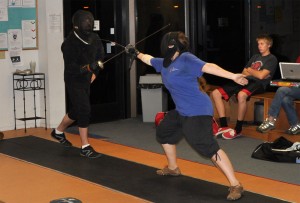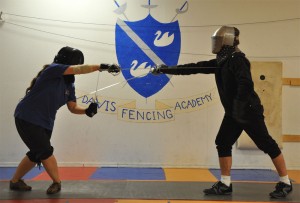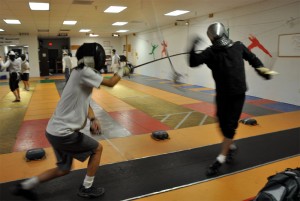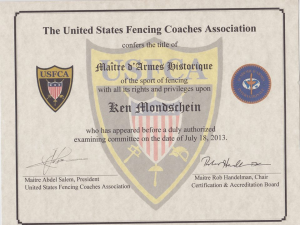What is a Maestro?
I’m reposting something here because I think a lot of people are overreacting in graceless ways to my announcement that Ken was granted his teaching certification.
I think this reveals a profound lack of knowledge and experience about what a fencing master actually did historically or does today. There is a bit too much Hollywood baggage in this discussion for my taste because there is nothing particularly glorious or kingly about running a fencing school which is what the title really means. Masters are not little old bearded men trashing ninjas by the hundreds. In fact masters often sacrifice their own competitive edge because they spend the larger portion of their time teaching. (The really good competitive artists in my experience are the younger provosts.)

I am not this guy.
In the classical tradition a master would run the school with a few provosts and a collection of instructors to assist with the workload. It is simply how you run a school and there is nothing weird or supernatural about it. If you are running your own school, you are doing the work of a fencing master.
There will be good fencing masters and bad ones. Fencing masters can and will hiss at each other like cats across the backyard fence just like any other two people enthusiastic about a particular field. Some masters will be lifelong friends and I’ve found that extremely rewarding. Helping guide Kevin Murakoshi through the process of his multiple examinations gave me a great sense of the circular nature of life and teaching. I have ensured that my work doesn’t end with me and I’ve empowered another teacher to go out into the world and make something good.
Now what you should understand is that I know a lot of masters working in the community but I only know a few people who are certified. I think that is a damn shame. I also find the process of examination and certification extremely powerful and rewarding so I’m strongly in favor of that experience for any teacher who runs a school. With that in mind I think schools should consider certifying masters and get beyond the mumbo-jumbo of Hollywood nonsense and restore the title to the work-a-day role that it really occupies which is something akin to a head football coach at your local high-school. Different certifications will produce different levels of talent and I’m comfortable with that provided that the process is public and verifiable.
(And, this is me being hit over and over again without ever getting a shot in.)
I earned my certification by being hit thousands upon thousands of times by students. Most fighters won’t know the difference between an in-time cue or an on-command cue. Amongst fencing teachers we can have thirty minute discussions and arguments on how best to cue a student’s attack. Fighting put me on the path to being a teacher but it wasn’t what was required for me to certify. Engendering success in the people around me so that they meet their goals is more important to me than my personal win-loss ratio. Building a historical swordplay community is the real prize that I keep my eyes on.
In order for the community to provide a healthy second and third generation we need lots of schools to experiment with lots of ways of certifying the next generation. That’s dynamic. It has conflicts and feedback and tension and a drive to compete with your sister schools. That is healthy.
In short, don’t panic… “master” is just a normal teaching credential. The USFCA certification is not my thing but I think certifying programs are where the community needs to go generally as we mature. I look forward to the HEMA Alliance program, and the USFCA program (conditional on Ken’s input), and perhaps other programs as well. This gives me a great deal of comfort to know that we’re creating a self-sustaining life-cycle for the art. We need teachers and I want them all to be good. They won’t all be good but I can try to put my finger on the scales when I can to help tip the balance towards quality.
~P.





